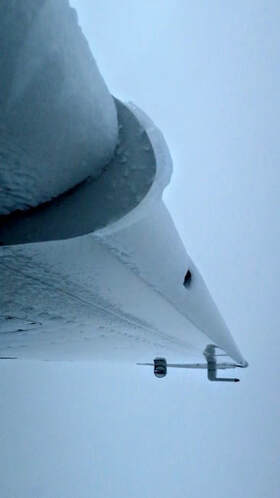|
Created By
Cardinal Aviation Founder: Ryan Van HarenAirline Transport Pilot, Air Traffic Controller, Coach, Consultant, Community Advocate. |
 Living, flying and training in a busy metropolitan airspace surrounded by mountains and ocean can make for some beautiful and challenging flying conditions. Unfortunately, one of the by products of the geography around Vancouver is the fact that it limits pilots to flying and conducting IFR training to only a handful of airports. The biggest limiting factor is the unforgiving IFR flight conditions over and around the mountains combined with the fact that most GA aircraft are of the single engine variety that rarely have onboard de-icing equipment. What ends up happening quite often is that an instrument rating earned in the Vancouver area gives pilots the legal right to fly IFR anywhere even if they have really only ever been exposed to a hand full of airports in the local area and they tend to stay in that theatre of operation. Eventually pilots gain the confidence to expand their area of operations and when they do is when the real learning begins. The Pilot This afternoon I received a call from a client. He is a safe and conscientious pilot who invests in recurrent training and has a very well equipped Cessna 210. He is not reckless, nor is he a cowboy. He regularly makes flights over the mountains but typically conducts these flights IFR either on VMC days or well on top of overcast layers. He knows his airplane but his flight experience in adverse conditions is somewhat limited. This client had called his coach in the past to discuss go/no-go decisions to get a second opinion. Scenario This client planned to fly his usual route today at 13,000ft and called FSS for a weather briefing. The briefer advised him that the freezing level was at 5000' ASL and that there was no forecast icing enroute. The pilot departed in VFR conditions with an IFR clearance. He entered cloud at 7000ft and no ice was detected. In the climb out of 9000ft he started experiencing what he described as heavy rain that made the sound of rain hitting a tin roof. The OAT was -10. Ice began accumulating on the windshield and upon inspection of the wings significant icing had built up on the leading edge of the wing as well as on the surfaces aft of the leading edge. The pilot knew that he was near the tops of the cloud layer and continued his climb. He managed to get on top and continued his flight to his destination and filed a PIREP with ATC. The ice slowly sublimated off the windscreen but remained on the wings for the duration of the flight. Compounding matters, upon reaching 13,000ft the pilot realised that his oxygen bottle had been left on after the last flight and was depleted. The Breakdown The pilot encountered freezing rain, it wasn't forecast and based on the information from the briefer he did not expect any icing en-route. Having never experienced these conditions he did not have the tools or experience necessary to assist his decision making but one thing that he did do correctly was continue flying the airplane. Advice From The Coach When this client sent me the photos of his encounter I told him that he was lucky to be alive! There is one thing that every experienced pilot will tell you whether they fly a Cessna or a Boeing and that is "FREEZING RAIN KILLS!" It is to be avoided at all costs and in the event of an inadvertent encounter keep your airspeed and GET OUT!!! LESSON #1 (The Dangers of Freezing Rain) The danger of freezing rain is that it does not freeze on initial contact with the airframe. Instead, super cooled water droplets flow along the surface and freeze aft of the leading edges which greatly alter the characteristics of the wing. Even in aircraft with de-icing boots, or hot wings freezing rain will freeze aft of the protective surfaces creating dangerous ridges that alter the shape of the wing. The presence of ice on the wing, especially in this quantity can easily cause the aircraft to be unable to maintain altitude and increase the stall speed by dozens of knots and decrease the critical angle of attack by a significant margin. You are now a test pilot! LESSON #2 (WX Briefings are Great But Your Eyes Are Better!) The pilot did all the right things in getting a weather briefing. Yes the briefer advised that there was no forecast icing enroute. The key here is word forecast. We all know that a forecast is an educated guess at best. Here is a very simple formula that every pilot should commit to memory. -- Clouds=Visible Moisture Visible Moisture + Below Freezing Temperatures = ICE -- Regardless of what any briefing says if you observe an OAT of temperatures below zero and are entering cloud or are flying through rain you will pick up ICE. Of all icing types, freezing rain is by far the most lethal. Trust what you are seeing out the window over what you heard on the phone. LESSON #3 (Most Controllers Are Not Pilots) Contrary to what they might tell you, Air Traffic Controllers do not know everything. They are not psychic and the majority are not pilots. In this scenario the pilot filed a PIREP. To the controller this is appreciated, nice to know information that will be passed on to other pilots. The problem is that most controllers do not know whether or not a Cessna 210 has de-icing boots or what the implications of ice on each type of aircraft are. It is up to the pilot to speak up and inform the controller what is happening and what they need. LESSON#4 MAYDAY MAYDAY MAYDAY (This is an Emergency!) Emergencies are not limited to engine failures and fires. In the case of this pilot, I would without a doubt say that he is lucky to be alive. If faced with this situation the correct response is to immediately declare an emergency (MAYDAY) and get out of the icing conditions while maintaining a higher than normal airspeed. Controllers have tools and lower altitudes available to them that are only useable in an emergency. LESSON #5 Swiss Cheese Slice #1 - Inadvertent Icing Encounter Slice#2 - Out of Oxygen Slice#3 - Fortunately did not come out to play. CONCLUSION Icing is to be avoided at all costs in aircraft that are not equipped for it. As pilots it is important that we expand our level of experience by pushing our comfort zones and using the privilege of our licenses and ratings to experience new things. In doing so we are bound to learn lessons, sometimes the hard way. The important thing is that we share these lessons with others so that they avoid bad situations and know what to do should they encounter them. Written By: Ryan Van Haren (Cardinal Aviation Coach)
Bruce Nicmans
10/8/2019 21:11:26
An excellent article! Comments are closed.
|
AuthorThe Cardinal Aviation Blog is a compilation of stories, tips, tricks and experiences from our Clients and Coaches. Some entries have a valuable learning lesson in them and some are to share some of what we are fortunate enough to experience when we fly. CategoriesAll ATC Tips Audio Briefings General Commentary IFR Tips Interesting Finds Podcast Related Content Text Archives
November 2021
|








 RSS Feed
RSS Feed